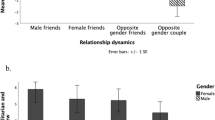Abstract
This empirical study examined predictors of conflict over the household division of labor among a group of 319 middle class, less traditional married women in order to examine the degree to which equity factors predicted conflict. Forty of the women were either African American, Hispanic, Native American, or Asian. An analysis of covariance indicated that there were no differences by race/ethnicity. The study explored the following: (1) the degree to which equity factors predict conflicts over household labor, (2) which equity factors best account for conflict, (3) the degree to which particular equity factors mediate the relationship of conflict with other variables, (4) whether equity factors are more compelling in predicting conflicts than practical or status variables, and (5) whether women's perceptions of the reasons for conflict put more emphasis on equity than on other issues. Results indicated that while both equity and practical factors predicted conflict, equity factors were more statistically significant. The best overall model of conflict suggested that it was predicted by lower satisfaction with the division of labor (which, in turn, was contingent upon time differentials between spouses and the time a womans' spouse spent on traditional women's tasks), a larger number of household members, a woman's younger age, and performing a greater number of overall household tasks. Equity is important to such women and constitutes a basis for making arguments about justice. However, these employed women devote twelve hours more per week to household labor than their partners and are relatively satisfied with the division. Chaeftz's theory of gender equity identifies where this sample of employed women may be located in the process of change.
Similar content being viewed by others
References
Benin, M. H., & Agostinelli, J. (1988). Husbands' and wives' satisfaction with the division of labor.Journal of Marriage and the Family, 50, 349–361.
Berk, S. F. (1985).The gender factory: The apportionment of work in American households. New York: Plenum.
Blair, S. L., & Johnson, M. P. (1992). Wives' perceptions of the fairness of the division of household labor: The intersection of housework and ideology.Journal of Marriage and the Family, 54, 570–481.
Blair, S. E., & Lichter, D. T. (1991). Measuring the division of household labor: Gender segregation of housework among American couples.Journal of Family Issues, 12, 91–113.
Brayfield, A. A. (1992). Employment resources and housework in Canada.Journal of Marriage and the Family, 54, 19–30.
Chafetz, J. S. (1990).Gender equity: An integrated theory of stability and change. Newbury Park, CA: Sage.
Coleman, M. T. (1988). The division of household labor: Suggestions for future empirical consideration and theoretical development.Journal of Family Issues, 9, 132–147.
Cowan, C., Cowan, P., Heming, G., Garrett, E., Coysh, W., Curtis-Boles, H., & Boles, A. J., III. (1985). Transitions to parenthood: His, hers, and theirs.Journal of Family Issues, 6, 451–481.
Ericksen, J. A., Yancey, W., & Ericksen, E. P. (1979). The division of family roles.Journal of Marriage and the Family, 41, 301–313.
Ferree, M. M. (1990). Beyond separate spheres: Feminism and family research.Journal of Marriage and the Family, 52, 886–884.
Held, V. (1984).Rights and goods: Justifying social action. New York: Free Press.
Hochschild, A. (1989).The second shift. New York: Viking.
Kamo, Y. (1988). Determinants of the household division of labor: Resources, power, and ideology.Journal of Family Issues, 9, 177–200.
Major, B. (1987). Gender, justice, and the psychology of entitlement. In P. Shaver & C. Hendricks (Eds.),Sex and Gender. Newbury Park, CA: Sage.
Manning, R. C. (1992).Speaking from the heart: A feminist perspective on ethics. Lanham, MD: Rowman and Littlefield.
Mederer, H. J. (1993). Division of labor in two-earner homes: Task accomplishment versus household management as critical variables in perceptions about family work.Journal of Marriage and the Family, 55, 133–145.
Miller, D. C. (1991).Handbook of research design and social measurement. Newbury Park, CA: Sage.
Ross, C. E. (1987). The division of labor at home.Social Forces, 65, 816–833.
Schafer, R. B., & Keith, P. (1981). Equity in marital roles across the family life cycle.Journal of Marriage and the Family, 43, 359–368.
Scheuble, L., & Johnson, D. R. (1993). Marital name change: Plans and attitudes of college students.Journal of Marriage and the Family, 55, 747–754.
Suitor, J. J. (1991). Marital quality and satisfaction with the division of household labor across the family life cycle.Journal of Marriage and the Family, 53, 221–230.
Thompson, L. (1991). Family work: Women's sense of fairness.Journal of Family Issues, 12, 181–196.
Walker, K., & Woods, M. (1976).Time use: A measure of household production of family goods and services. Washington, DC: American Home Economics Association.
White, L., Booth, A., & Edwards, J. (1986). Children and marital happiness: Why the negative correlation?Journal of Family Issues, 7, 131–148.
Author information
Authors and Affiliations
Additional information
Thanks to Diane Blohowiak for statistical assistance and to Susan Jacquet, Laura Thieme, Annette Tierrien, and Mark Hoven Stohs for assistance with data gathering. Special thanks to the reviewers.
Rights and permissions
About this article
Cite this article
Stohs, J.H. Predictors of conflict over the household division of labor among women employed full-time. Sex Roles 33, 257–275 (1995). https://doi.org/10.1007/BF01544614
Issue Date:
DOI: https://doi.org/10.1007/BF01544614




